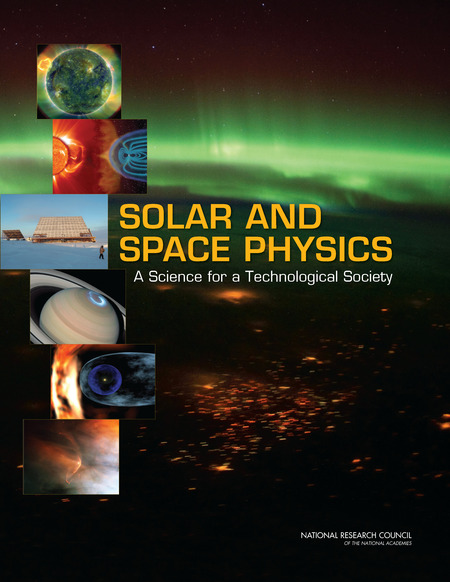Progress Made Toward Priorities of 2013-2022 Heliophysics Decadal Survey
This post is adapted from a National Academies press release: NASA, the National Science Foundation (NSF), and the National Oceanic and Atmospheric Administration (NOAA) have made substantial progress in implementing the programs recommended in the 2013 decadal survey on solar and space physics (heliophysics) despite a challenging budgetary landscape, says a new midterm assessment from the National Academies of Sciences, Engineering, and Medicine. Heliophysics is the study of the Sun, its influences on the planets of our solar system, and its interaction with interstellar space. It is also the science behind space weather.
NASA, the National Science Foundation (NSF), and the National Oceanic and Atmospheric Administration (NOAA) have made substantial progress in implementing the programs recommended in the 2013 decadal survey on solar and space physics (heliophysics) despite a challenging budgetary landscape, says a new midterm assessment from the National Academies of Sciences, Engineering, and Medicine. Heliophysics is the study of the Sun, its influences on the planets of our solar system, and its interaction with interstellar space. It is also the science behind space weather.
The decadal survey, Solar and Space Physics: A Science for a Technological Society, recommended research organized around key scientific goals, including establishing the origins of the Sun’s activity and understanding the interaction of the Sun within the solar system and interstellar medium. It also provided a number of research recommendations to reach those goals that take into account logistical hurdles. The new midterm assessment measures the progress made by NASA, NSF, and NOAA so far and makes recommendations for preparing for the next decadal survey.
“Heliophysics is a discovery science that is deeply connected to questions of life and habitability and thus embodies fundamental questions about the origin and fate of habitable planetary environments,” said Thomas Woods, associate director of technical divisions in the Laboratory for Atmospheric and Space Physics at the University of Colorado, Boulder, and co-chair of the committee that conducted the assessment. “The influence of these processes is increasingly important here on Earth as our society becomes more dependent on technologies that are impacted by space weather.”
The NASA Heliophysics Division (HPD) budget has risen less than the rate of inflation since the decadal survey, reducing purchasing power. This contributed to a delay in implementation of the next Solar-Terrestrial Probes (STP) mission, which was recommended in the decadal survey, and an inability to start other recommended STP missions. Despite this, NASA successfully launched three large-class heliophysics missions, selected additional Explorers for development, initiated the science definition for its next Living With a Star mission, and saw growth in its CubeSat program. NASA and NSF have also achieved their goals on most elements of the Diversify, Realize, Integrate, Venture, Educate (DRIVE) initiative. The DRIVE organizational framework focuses on maximizing the scientific potential of existing space- and ground-based assets, by implementing new ways to exploit existing data, combining data from a diverse range of observing platforms, and investing in modeling efforts.
“Since the decadal survey, we have seen a series of major scientific advances in solar and space physics,” said Robyn Millan, committee co-chair, and a professor of physics and astronomy at Dartmouth College. “Many of these advances are sparked by new instrumentation and the new perspectives that result from advances in theory, modeling, and computation.”
Space weather also featured prominently in the decadal survey, which recommended how NASA, NSF, and NOAA should coordinate and execute programs to better understand and forecast space weather and its effects. While limited funding similarly constrained or delayed the space weather programs at these agencies, recent progress shows promise toward meeting the decadal survey goals.
The committee made recommendations for the remainder of the decade for the DRIVE initiative, the Heliophysics Explorers program, space weather, and heliophysics career enhancements. Among the recommendations:
- NASA and NSF should continue to use the DRIVE framework within their research and analysis programs.
- NASA should develop a more efficient management environment and an improved contract/grant structure for its Heliophysics Explorers program.
- NASA, NSF, and NOAA should develop an implementation roadmap to advance space weather science and agency capabilities for research and operations.
- NASA, NSF, and NOAA should develop strategic plans for the heliophysics workforce with goals to improve the diversity of race, gender, age, and country of origin, such as increased opportunities for mentoring and anonymity during proposal and review processes.
To prepare for the next decadal survey, the midterm assessment recommends that NASA HPD conduct a demographics and diversity survey to understand how the research community’s demographics have evolved and to assess what progress has occurred in enhancing diversity. The midterm assessment also recommends that NASA and NSF should implement and fund advanced planning for the next decadal survey that involves the community in strategic planning of the next decade science challenges, science goals, and related high priority measurements.
The assessment — undertaken by the Committee on the Review of Progress Toward Implementing the Decadal Survey — Solar and Space Physics: A Science for a Technological Society — was sponsored by NASA.

